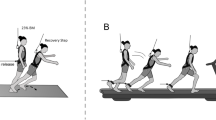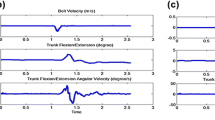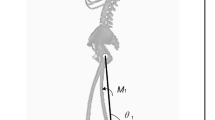Abstract
Studies examining recovery from SLIPS and TRIPS indicate higher incidence of falls during SLIPS than TRIPS however, differences in the recovery mechanisms during these opposing perturbations have not been examined. We therefore aimed to compare the reactive balance responses contributing to fall risk during SLIPS and TRIPS at comparable perturbation intensity among community-dwelling healthy adults and chronic stroke survivors. Younger adults (N = 11), age-matched adults (N = 11) and chronic stroke survivors (N = 12) were exposed to a single SLIP and TRIP through a motorized treadmill (16 m/s2 , 0.20 m). Center of mass (COM) state stability was measured by recording COM position and velocity relative to base of support, i.e., Ḋ COM/BOS and Ẋ COM/BOS, respectively. Trunk and compensatory step kinematics were also recorded. During SLIPS, the incidence of falls among stroke survivors was greater than healthy adults (53.83% vs. 0%), however not for TRIPS. All groups showed higher change in postural stability from liftoff to touchdown during TRIPS than SLIPS. Among healthy adults higher change in Ḋ COM/BOS during TRIPS was accompanied by the ability to control trunk flexion at step touchdown and lower peak trunk velocity as compared with SLIPS, with no significant differences in compensatory step length between the perturbations (p > 0.05). Chronic stroke survivors increased compensatory step length during TRIPS versus SLIPS (p < 0.05) contributing to greater stability change. They were unable to control trunk excursion and peak trunk velocity as compared with the healthy adults leading to lower stability than healthy younger and age-matched adults during SLIPS and lower stability than younger adults during TRIPS. Difficulty in trunk control during SLIPS among all individuals and compensatory step length among stroke survivors emphasizes higher fall risk for SLIPS than TRIPS among these populations.



Similar content being viewed by others
References
Batchelor FA, Hill KD, Mackintosh SF, Said CM, Whitehead CH (2012) Effects of a multifactorial falls prevention program for people with stroke returning home after rehabilitation: a randomized controlled trial. Arch Phys Med Rehabil 93:1648–1655. https://doi.org/10.1016/j.apmr.2012.03.031
Bhatt T, Wening JD, Pai YC (2006) Adaptive control of gait stability in reducing slip-related backward loss of balance. Exp Brain Res 170:61–73. https://doi.org/10.1007/s00221-005-0189-5
Bhatt T, Espy D, Yang F, Pai YC (2011) Dynamic gait stability, clinical correlates, and prognosis of falls among community-dwelling older adults. Arch Phys Med Rehabil 92:799–805. https://doi.org/10.1016/j.apmr.2010.12.032
Bhatt T, Yang F, Pai YC (2012) Learning to resist gait-slip falls: long-term retention in community-dwelling older adults. Arch Phys Med Rehabil 93:557–564. https://doi.org/10.1016/j.apmr.2011.10.027
Blouin JS, Inglis JT, Siegmund GP (2006) Auditory startle alters the response of human subjects exposed to a single whiplash-like perturbation. Spine (Phila Pa 1976) 31:146–154
Carbonneau E, Smeesters C (2014) Effects of age and lean direction on the threshold of single-step balance recovery in younger, middle-aged and older adults. Gait Posture 39:365–371. https://doi.org/10.1016/j.gaitpost.2013.08.013
Crenshaw JR, Rosenblatt NJ, Hurt CP, Grabiner MD (2012) The discriminant capabilities of stability measures, trunk kinematics, and step kinematics in classifying successful and failed compensatory stepping responses by young adults. J Biomech 45:129–133. https://doi.org/10.1016/j.jbiomech.2011.09.022
Davis RB III, Ounpuu S, Tyburski D, Gage JR (1991) A gait data collection and reduction technique. Hum Mov Sci 10:575–577
Feng H (1999) Limits of stability and postural sway in young and older people. Master’s thesis, Queen’s University, Ontario, pp 52–55
Grabiner MD, Donovan S, Bareither ML, Marone JR, Hamstra-Wright K, Gatts S, Troy KL (2008) Trunk kinematics and fall risk of older adults: translating biomechanical results to the clinic. J Electromyogr Kinesiol 18:197–204. https://doi.org/10.1016/j.jelekin.2007.06.009
Han J, Betker AL, Szturm T, Moussavi Z (2006) Estimation of the center of body mass during forward stepping using body acceleration. Conf Proc IEEE Eng Med Biol Soc 1:4564–4567. https://doi.org/10.1109/iembs.2006.260458
Harris JE, Eng JJ, Marigold DS, Tokuno CD, Louis CL (2005) Relationship of balance and mobility to fall incidence in people with chronic stroke. Phys Ther 85:150–158
Hof AL (2008) The ‘extrapolated center of mass’ concept suggests a simple control of balance in walking. Hum Mov Sci 27:112–125. https://doi.org/10.1016/j.humov.2007.08.003
Honeycutt CF, Nevisipour M, Grabiner MD (2016) Characteristics and adaptive strategies linked with falls in stroke survivors from analysis of laboratory-induced falls. J Biomech. https://doi.org/10.1016/j.jbiomech.2016.08.019
Hsiao ET, Robinovitch SN (1998) Common protective movements govern unexpected falls from standing height. J Biomech 31:1–9
Hsiao-Wecksler ET (2008) Biomechanical and age-related differences in balance recovery using the tether-release method. J Electromyogr Kinesiol 18:179–187. https://doi.org/10.1016/j.jelekin.2007.06.007
Jorgensen HS, Nakayama H, Raaschou HO, Olsen TS (1999) Stroke. Neurologic and functional recovery the Copenhagen Stroke Study. Phys Med Rehabil Clin N Am 10:887–906
Jung K, Kim Y, Chung Y, Hwang S (2014) Weight-shift training improves trunk control, proprioception, and balance in patients with chronic hemiparetic stroke. Tohoku J Exp Med 232:195–199
Kajrolkar T, Bhatt T (2016) Falls-risk post-stroke: Examining contributions from paretic versus non paretic limbs to unexpected forward gait slips. J Biomech 49:2702–2708. https://doi.org/10.1016/j.jbiomech.2016.06.005
Kajrolkar T, Yang F, Pai YC, Bhatt T (2014) Dynamic stability and compensatory stepping responses during anterior gait–slip perturbations in people with chronic hemiparetic stroke. J Biomech 47(11):2751–2758. https://doi.org/10.1016/j.jbiomech.2014.04.051
Lamb SE, Ferrucci L, Volapto S, Fried LP, Guralnik JM, Women’s H, Aging S (2003) Risk factors for falling in home-dwelling older women with stroke: the Women’s Health and Aging Study. Stroke 34:494–501
Lockhart TE, Woldstad JC, Smith JL (2003) Effects of age-related gait changes on the biomechanics of slips and falls. Ergonomics 46:1136–1160. https://doi.org/10.1080/0014013031000139491
Lubetzky-Vilnai A, Kartin D (2010) The effect of balance training on balance performance in individuals poststroke: a systematic review. J Neurol Phys Ther 34:127–137. https://doi.org/10.1097/NPT.0b013e3181ef764d
Maki BE, McIlroy WE (1997) The role of limb movements in maintaining upright stance: the “change-in-support” strategy. Phys Ther 77:488–507
Mansfield A, Inness EL, Wong JS, Fraser JE, McIlroy WE (2013) Is impaired control of reactive stepping related to falls during inpatient stroke rehabilitation? Neurorehabil Neural Repair 27:526–533. https://doi.org/10.1177/1545968313478486
Marigold DS, Patla AE (2002) Strategies for dynamic stability during locomotion on a slippery surface: effects of prior experience and knowledge. J Neurophysiol 88:339–353. https://doi.org/10.1152/jn.00691.2001
Newton RA (2001) Validity of the multi-directional reach test: a practical measure for limits of stability in older adults. J Gerontol A Biol Sci Med Sci 56:M248–M252
Pai YC, Iqbal K (1999) Simulated movement termination for balance recovery: can movement strategies be sought to maintain stability in the presence of slipping or forced sliding? J Biomech 32:779–786
Pai YC, Wening JD, Runtz EF, Iqbal K, Pavol MJ (2003) Role of feedforward control of movement stability in reducing slip-related balance loss and falls among older adults. J Neurophysiol 90:755–762. https://doi.org/10.1152/jn.01118.2002
Parijat P, Lockhart TE (2012) Effects of moveable platform training in preventing slip-induced falls in older adults. Ann Biomed Eng 40:1111–1121. https://doi.org/10.1007/s10439-011-0477-0
Patel P, Bhatt T (2015) Adaptation to large-magnitude treadmill-based perturbations: improvements in reactive balance response. Physiol Rep 3 https://doi.org/10.14814/phy2.12247
Pavol MJ, Pai YC (2002) Feedforward adaptations are used to compensate for a potential loss of balance. Exp Brain Res 145:528–538. https://doi.org/10.1007/s00221-002-1143-4
Pavol MJ, Owings TM, Foley KT, Grabiner MD (1999) Gait characteristics as risk factors for falling from trips induced in older adults. J Gerontol A Biol Sci Med Sci 54:M583–M590
Redfern MS, Cham R, Gielo-Perczak K et al (2001) Biomechanics of slips. Ergonomics 44:1138–1166. https://doi.org/10.1080/00140130110085547
Salot P, Patel P, Bhatt T (2016) Reactive balance in individuals with chronic stroke: biomechanical factors related to perturbation-induced backward falling. Phys Ther 96:338–347. https://doi.org/10.2522/ptj.20150197
Siegmund GP, Blouin JS, Inglis JT (2008) Does startle explain the exaggerated first response to a transient perturbation? Exerc Sport Sci Rev 36:76–82. https://doi.org/10.1097/JES.0b013e318168f1ce
Srivastava A, Taly AB, Gupta A, Kumar S, Murali T (2009) Post-stroke balance training: role of force platform with visual feedback technique. J Neurol Sci 287:89–93. https://doi.org/10.1016/j.jns.2009.08.051
Tan JS, Eng JJ, Robinovitch SN, Warnick B (2006) Wrist impact velocities are smaller in forward falls than backward falls from standing. J Biomech 39:1804–1811. https://doi.org/10.1016/j.jbiomech.2005.05.016
Tantisuwat A, Chamonchant D, Boonyong S (2014) Multi-directional reach test: an investigation of the limits of stability of people aged between 20–79 years. J Phys Ther Sci 26:877–880. https://doi.org/10.1589/jpts.26.877
Yang F, Bhatt T, Pai YC (2009) Role of stability and limb support in recovery against a fall following a novel slip induced in different daily activities. J Biomech 42:1903–1908. https://doi.org/10.1016/j.jbiomech.2009.05.009
Yatar GI, Yildirim SA (2015) Wii Fit balance training or progressive balance training in patients with chronic stroke: a randomised controlled trial. J Phys Ther Sci 27:1145–1151. https://doi.org/10.1589/jpts.27.1145
Acknowledgements
This study was supported by the American Heart Association, Scientific Development grant (12SDG12170022). The authors would like to thank Abdul Karim, Harish Reddy and Juana Villagomez for assistance with data processing.
Author information
Authors and Affiliations
Corresponding author
Ethics declarations
Conflict of interest
The authors have no conflict of interest.
Rights and permissions
About this article
Cite this article
Patel, P.J., Bhatt, T. Fall risk during opposing stance perturbations among healthy adults and chronic stroke survivors. Exp Brain Res 236, 619–628 (2018). https://doi.org/10.1007/s00221-017-5138-6
Received:
Accepted:
Published:
Issue Date:
DOI: https://doi.org/10.1007/s00221-017-5138-6




